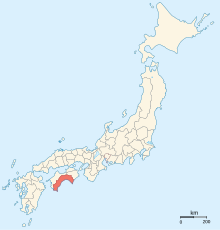Tosa Province

Tosa ( Japanese 土 佐 国 , Tosa no kuni ) or Doshū ( 土 州 ) was an ancient province on the island of Shikoku in Japan . It corresponds to today's Kōchi Prefecture .
Between 1470 and 1573, after the Hosokawa had lost all authority , the province was ruled by the Tosa-Ichijō ( 土 佐 一条 氏 ), a sideline of the noble Ichijō . The sideline is descended from Ichijō Norifusa . The last head of the family Ichijō Kanesada ( 一條 兼 貞 ; 1543–85) lost land and power to his vassal Chōsokabe Motochika after 1568 . His rule was again destroyed by Toyotomi Hideyoshi's campaign in 1585.
Yamanouchi Kazutoyo (1546-1605) fought on the side of Tokugawa Ieyasu, who gave him Tosa as a fief in 1600. With the associated income of 242,000 Koku , he was one of the great daimyo. His descendant Yamanouchi Yōdō (1827–1872) was one of the strongest supporters of the abolition of the shogunate and the restoration of the Tennō in his old rights. The best-known samurai of the Tokugawa opponents of Tosa-han, Sakamoto Ryōma , who was murdered in 1867 on the orders of the shogunate, is venerated to this day.
Tosa is famous for the Tosa dogs ( Tosa inu ) named after the province , a cross between bulldog , mastiff and native breeds, among others .
Tosa is also the namesake of Tosa Nikki ( 土 佐 日記 ), a diary novel by Ki no Tsurayuki from 935, the first significant work in Japanese diary literature . It describes the return of the governor of Tosa - the author himself - to the then capital Kyoto from the point of view of a lady-in-waiting of the entourage.
Tosa is also the name of a city in the center of Kōchi prefecture with about 30,000 inhabitants.
See also Yamanouchi clan .
literature
- E. Papinot: Historical and Geographical Dictionary of Japan. Reprint of the original 1910 edition. Tuttle-Verlage, 1972, ISBN 0-8048-0996-8 .
Coordinates: 33 ° 37 ' N , 133 ° 24' E